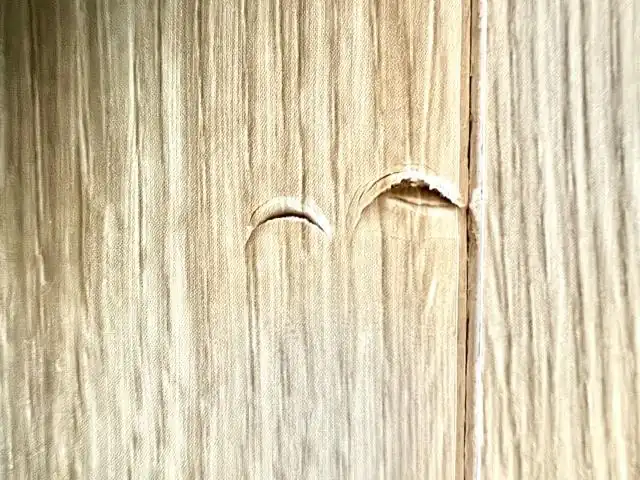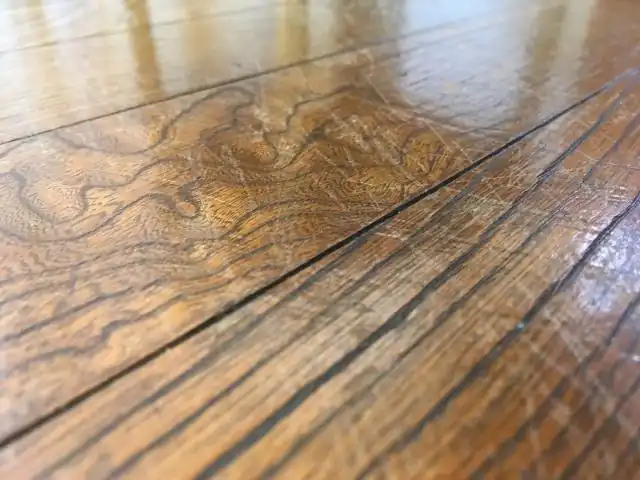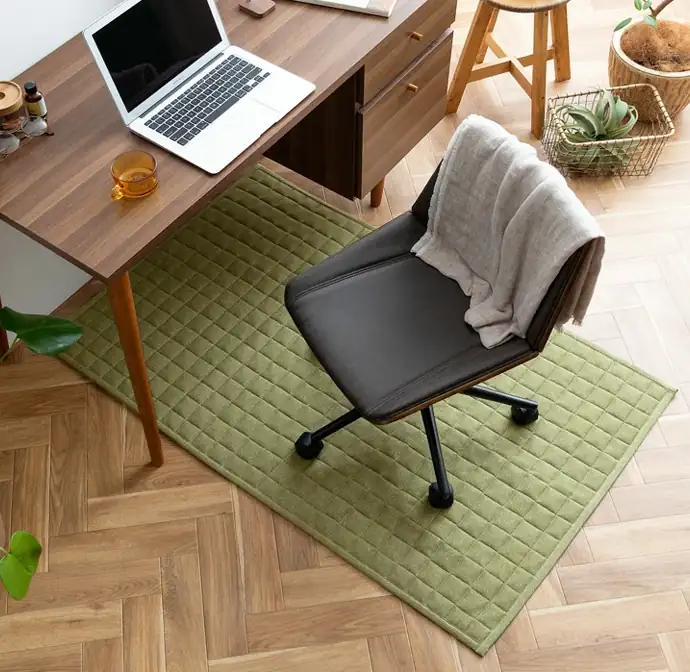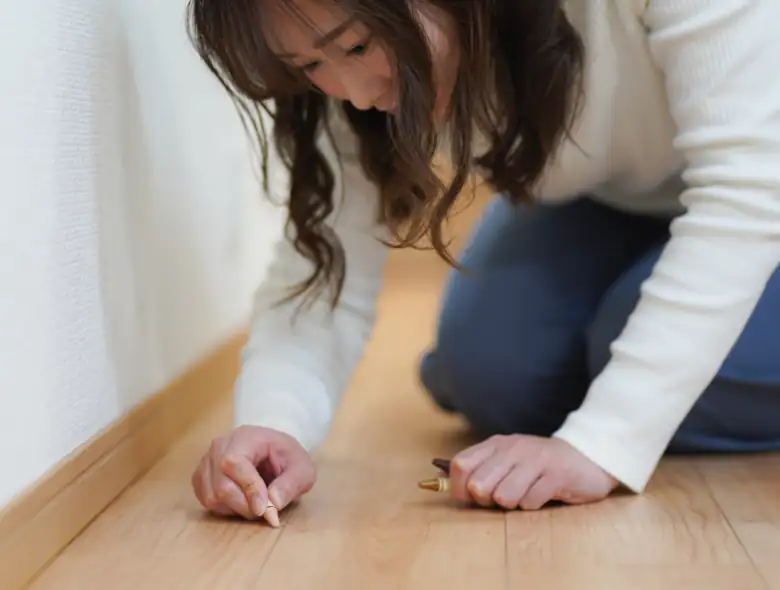When living in a rental home, scratches and dents are bound to occur, especially on hardwood floors. These imperfections can be particularly concerning, as many people worry about the potential repair costs when it’s time to move out.
Typically, if you have maintained the property well, you may only be responsible for standard cleaning costs when moving out. However, scratches and dents resulting from negligence could be considered your responsibility for repair.
In this article, we’ll guide you through the steps to repair scratches and dents on hardwood flooring in rental properties. We’ll also clarify who is typically responsible for covering the repair costs, depending on the type of damage. Additionally, we’ll provide tips on fixing minor imperfections. Use this as a reference for maintaining your floors.
Village House manages over 1,000 properties across Japan. If you’re searching for a new place to call home, please visit our website for more information and explore your options.
Repairing Flooring Damage in Rental Properties

As of April 2020, recent legal amendments to rental contracts have clarified tenant responsibilities for property repairs. Tenants are now accountable for the costs associated with damage resulting from intentional or negligent actions, or failure to maintain the property. Conversely, landlords are responsible for addressing unavoidable deterioration and wear and tear from everyday living.
In essence, tenants are only liable for damages that exceed normal wear and tear and for restoring the property to its original condition. The security deposit typically covers repair costs upon moving out. However, an additional payment will be required if the repair costs surpass the security deposit amount or if no deposit was collected.
Fixing Scratches and Dents with Repair Kits or an Iron

Source: Rakuten
Using a repair kit for shallow scratches on flooring
Repair kits for shallow scratches are available at home improvement stores or online, typically priced between 1,000 to 5,000 yen. However, before using the repair kit, make sure to test it on a small, inconspicuous scratch. This ensures the color matches and the repair blends seamlessly with the existing floor. If the color is mismatched or the repair is too noticeable, it could potentially make the floor look worse.
Repairing dents in flooring with an iron
Wood expands when it absorbs moisture and is exposed to heat. If you have solid wood flooring, you can use an iron to repair dents and make them less noticeable. However, avoid using an iron on composite flooring, as the surface coating may peel off. Also, be cautious with solid wood flooring that has a coating, as ironing will not be effective for repairs and could cause further damage.
If the repair does not produce satisfactory results or if the condition of the flooring deteriorates, repair costs may rise. To prevent further damage, consider placing rugs or carpets to protect the floor and reduce the likelihood of additional scratches or dents.
Cases in which the Tenant is Responsible for Covering Repair Costs

- Scratches and dents caused by dropping something on the floor
- Scratches caused when moving furniture
- Scratches caused by chair casters
- Scratches caused by dogs and cats, etc.
The cost of flooring repairs can vary significantly based on the type of flooring material and the repair service used. According to the Ministry of Land, Infrastructure, Transport, and Tourism’s Trouble Regarding Restoration to Original Condition and Related Guidelines, repairs should be kept to a minimum as a general rule. However, flooring color can vary between sections. Therefore, a complete replacement is often required.
In some cases, fire insurance may cover the repair costs of scratches on flooring, provided the policy includes a “tenant liability special clause.”
Additionally, the cause of the damage must be limited to “unforeseen and sudden accidents,” such as accidentally dropping an item or a child dropping dishes. Damage from other causes, such as dents or other types of damage, is also covered.
Landlord’s Responsibility: Deterioration from Natural Wear and Tear or Aging over Time

- Scratches and dents that existed before moving in
- Sun-damaged flooring and wallpaper
- Discolored flooring and peeling wallpaper due to leaks
- Dents and sun marks caused by installed furniture, etc.
According to the guidelines, the landlord is responsible for repair costs related to scratches and dents from unavoidable daily wear and tear, as well as cracks and discoloration caused by natural deterioration. Additionally, the landlord is responsible for damage caused by natural disasters, repair of pin marks, and replacement of equipment that fails due to normal wear and tear.
Floor Damage Prevention Methods

Source: Rakuten
Laying carpets or rugs
Laying carpets or rugs is an effective way to prevent dents in the flooring. You can safeguard the floor from damage throughout your stay by placing them before moving in and arranging your furniture. For an area of approximately 6 tatami mats, you can find suitable options for under 10,000 yen. Additionally, affordable, pre-assembled mats are available, which can be a convenient and cost-effective solution. We recommend using these mats to offer extra protection for your flooring.
Use chair mats under chairs with casters
Many people who work remotely or from home use chairs with casters, which can often cause scratches on the floor.
While covering the entire floor with carpets is one solution, a more targeted approach is to use chair mats specifically designed to protect the flooring in the areas where chairs are used. Chair mats are an effective and economical option, with basic models costing between 2,000 and 3,000 yen. For enhanced soundproofing, higher-quality mats are available for around 10,000 yen.
Put special protective covers on the legs of the furniture
Apply protective covers to the legs of tables, chairs, and other furniture to prevent scratches and dents on your flooring. Even with careful use, moving or pulling chairs can still cause damage. Protective covers are readily available and affordable at 100-yen stores, making them a simple yet effective solution to safeguard your floors.
Place floorboards under heavy furniture
Heavy furniture and appliances, such as cupboards and refrigerators, can easily cause dents in the flooring. To prevent this, place floor protectors or boards underneath them. These protective solutions can be found online or at home improvement stores.
No Responsibility for Pre-Move-In Floor Scratches

If you can prove that scratches or dents were present before you moved in, you will not be held responsible for their repair. Many management companies provide an “interior checklist” or “current condition confirmation document” with the keys.
Thoroughly inspect the interior for any existing damage such as scratches or dents before you bring your belongings in. We recommend taking detailed photographs to document the condition if you find any issues. These images will serve as evidence that the damage was pre-existing, helping you avoid disputes when you move out.
Be aware that there is a deadline for submitting the interior checklist—usually within 1 to 2 weeks of moving in. Missing this deadline may result in the damage being considered your responsibility, so be sure to complete and return the checklist promptly.
What to Do if You’re Concerned About Repair Costs

If you’ve been charged for repairs of scratches or dents that were present before you moved in, it’s important to contact the management company or landlord to discuss the issue. Depending on the content, there is a possibility that the claim might be waived or reduced.
Additionally, consider consulting with the experts listed below for further assistance. When reaching out, you can request advice by stating, “I’d like to discuss the costs related to restoring the property to its original condition.” This approach will help you get the appropriate guidance on handling repair disputes effectively.
| Consumer Affairs Hotline | Phone number: 116 Reception hours: Varies by prefecture |
| National Consumer Affairs Center of Japan | Phone number: 03-3446-1623 Reception hours: 10:00-12:00, 13:00-16:00 Excluding weekends, holidays, and New Year holidays |
| Japan Consumer Association | Phone number: 03-5282-5319 Reception hours: 10:00-12:00, 13:00-15:00 Tuesday, Thursday, Friday |
| Real Estate Transaction Improvement Organization | Phone number: 0570-021-030 Reception hours: 10:00-16:00 Excluding weekends, holidays, and New Year holidays |
| Japan Rental Housing Management Association | Consultations are accepted in writing (web form, fax, mail) Reception hours: 10:00-17:00 Excluding weekends and holidays |
| Legal Affairs Bureau | Phone number: 0570-078-374 Hours: Weekdays 9:00-21:00, Saturdays 9:00-17:00 Excluding Sundays, holidays, and New Year holidays |
For properties managed by Village House, the cost of moving out is determined by the Ministry of Land, Infrastructure, Transport, and Tourism’s Trouble Regarding Restoration to Original Condition and Related Guidelines“. If you are looking for a new place to move to, you can rest assured that you can choose a rental property from Village House.
Related articles:
- 5 Tips on How To Maintain A Damage-Free Apartment
- Rental Apartment Woes? Here’s Where to Get Expert Advice!
- Tips on How to Repair Minor Damages to Get Your Deposit Back
- No-Damage Shelves Without Nails
- How to Decorate Walls Without Damage

Hello, I’m Machiko Doi, a freelance writer who writes about housing and living in Japan.
I live in an 80-year-old house that I inherited from my grandparents along with my two shelter cats and daughter.
We live a relaxed life while repairing the house.
I like to cook vegetables from the garden and fresh fish caught by my father, and enjoy them with cold beer on a hot day or hot sake on a cold day.



